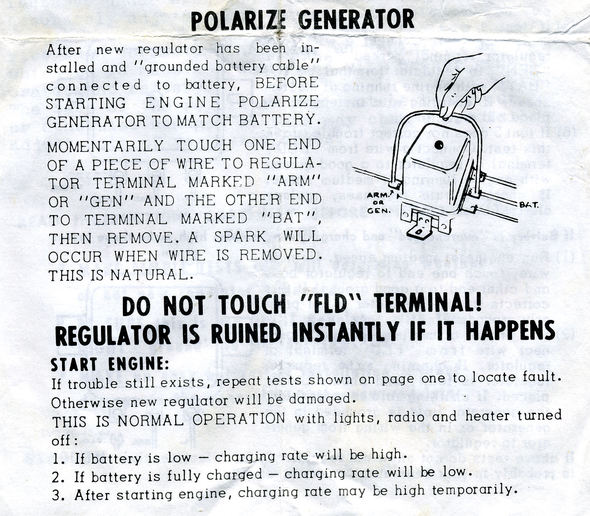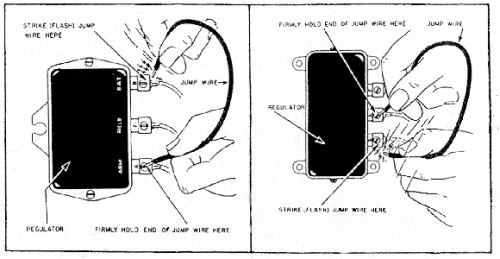To polarize a generator, briefly connect the generator’s field terminal to the battery’s positive terminal. This ensures proper magnetization.
Polarizing a generator is a crucial step to ensure it operates correctly. Without polarization, the generator may not produce the right voltage, potentially damaging electrical components. This simple procedure aligns the magnetic field within the generator with the electrical system of your vehicle or equipment.
Failing to polarize can lead to reversed polarity, causing inefficient performance or complete malfunction. Always consult the generator’s manual for specific instructions. Proper polarization helps maintain your generator’s efficiency and longevity. Regular maintenance, including polarization, ensures your generator remains reliable and functional.

Credit: forums.yesterdaystractors.com
Safety Precautions
Polarizing a generator is not hard, but safety is key. Always follow proper safety measures to avoid any risks. This section covers essential safety tips.
Personal Protective Equipment
- Wear insulated gloves to protect your hands.
- Use safety goggles to shield your eyes from sparks.
- Wear long sleeves and pants to protect your skin.
- Use non-slip shoes to avoid falls.
Electrical Safety Tips
- Turn off the generator before starting any work.
- Disconnect the battery to avoid electric shocks.
- Use insulated tools when working with electricity.
- Check for frayed wires and replace them if needed.
- Work in a dry area to avoid water-related accidents.
Identify Generator Type
Identifying your generator type is crucial before attempting to polarize it. It helps you understand the specific requirements and steps needed. Knowing whether your generator is AC or DC is the first step. Different types need different procedures. Let’s dive into how to identify your generator type.
Ac Vs. Dc Generators
AC Generators produce alternating current. The current flows in multiple directions. These generators are common in homes and businesses. They are efficient and versatile. AC generators are often used for large-scale power needs.
DC Generators produce direct current. The current flows in one direction. These generators are typically used in smaller applications. They are common in automotive and portable devices. DC generators are simpler and less expensive.
| Feature | AC Generator | DC Generator |
|---|---|---|
| Current Type | Alternating Current (AC) | Direct Current (DC) |
| Usage | Homes, businesses | Automotive, portable devices |
| Efficiency | High | Moderate |
| Cost | Higher | Lower |
Common Models
Here are some common models of generators you may encounter:
- Honda EU2200i – A popular portable AC generator for home use.
- Generac GP3000i – Known for its efficiency and power output.
- Briggs & Stratton P2200 – Ideal for small outdoor events and activities.
- Champion 3400-Watt Dual Fuel – Versatile, can run on gas or propane.
- Yamaha EF2000iSv2 – Reliable and efficient, perfect for camping.
Each of these models has specific features. Understanding these helps in the polarization process. Make sure to check your generator’s manual. This ensures you follow the correct steps for polarization.
Preparation Steps
Before polarizing a generator, follow these preparation steps. Proper preparation ensures safety and effectiveness. Let’s dive into the essential steps.
Disconnecting The Battery
First, disconnect the battery. This prevents any accidental short circuits.
Follow these steps to disconnect the battery:
- Turn off the ignition switch.
- Locate the battery in your vehicle.
- Using a wrench, loosen the negative terminal first.
- Remove the negative cable and set it aside.
- Loosen the positive terminal next.
- Remove the positive cable and set it aside.
Ensure the cables do not touch each other or any metal parts. Double-check the battery is fully disconnected before proceeding.
Inspecting The Generator
Next, inspect the generator. Look for any visible damage or wear.
Here are the steps to inspect the generator:
- Check the generator housing for cracks or dents.
- Inspect the wiring for frayed or exposed wires.
- Ensure all connections are tight and secure.
- Look at the brushes and commutator for excessive wear.
Use a flashlight to get a better view of hard-to-see areas. Address any issues before moving forward.
Following these preparation steps ensures a smooth polarization process. Properly disconnect the battery and inspect the generator thoroughly. Safety and attention to detail are crucial.
Polarizing Procedure
Polarizing a generator is essential to ensure it generates the correct voltage. This procedure aligns the magnetic field with the generator’s circuitry. Follow these steps to polarize both DC and AC generators.
Polarizing A Dc Generator
DC generators need proper polarization for effective functioning. Follow these steps:
- Turn off the Generator: Ensure the generator is off and disconnected.
- Identify Terminals: Locate the Field and Armature terminals.
- Connect a Jumper Wire: Use a jumper wire to connect the Battery Positive terminal to the Field terminal. Hold for a few seconds.
- Remove the Jumper Wire: Disconnect the jumper wire carefully.
- Reconnect the Generator: Reconnect all wires and turn the generator on.
Polarizing An Ac Generator
AC generators are polarized differently. Follow these steps:
- Turn Off the Generator: Make sure the generator is off.
- Identify the Exciter Terminals: Locate the positive and negative exciter terminals.
- Apply Voltage: Use a 12V battery. Connect the positive terminal of the battery to the positive exciter terminal. Connect the negative terminal of the battery to the negative exciter terminal for a few seconds.
- Disconnect the Battery: Remove the battery connections.
- Restart the Generator: Turn the generator back on to check if it is generating the correct voltage.
These steps ensure your generator works efficiently and safely.
Testing The Generator
After polarizing your generator, it’s important to test it. This ensures the generator is functioning properly. We’ll guide you through the steps to make sure everything is in working order. Follow these steps to test the generator effectively.
Reconnecting The Battery
First, reconnect the battery. Make sure the connections are clean and tight. Loose or dirty connections can cause problems. Follow these steps for reconnecting the battery:
- Locate the positive and negative terminals on the battery.
- Attach the positive cable to the positive terminal.
- Attach the negative cable to the negative terminal.
- Ensure both cables are secure and free of corrosion.
Using A Voltmeter
Next, use a voltmeter to test the generator. A voltmeter measures the electrical output. Here’s how to use it:
- Turn off the vehicle and disconnect the voltmeter.
- Set the voltmeter to measure voltage.
- Connect the voltmeter leads to the generator terminals.
- Start the vehicle and read the voltmeter display.
The voltmeter should show a voltage between 13.5 and 14.5 volts. This range indicates the generator is working correctly. If the reading is outside this range, there may be an issue with the generator or its connections. Check the connections again or consult a professional for further assistance.
Troubleshooting Issues
Polarizing a generator can sometimes be tricky. Issues may arise during the process. This section covers common problems and their solutions.
Common Problems
Below are some common issues you might face:
- No Output Voltage – The generator produces no voltage.
- Low Voltage Output – The voltage is lower than expected.
- Overheating – The generator gets too hot.
- Sparking – Sparks appear around the brushes.
Solutions And Fixes
Here are some solutions to fix the common problems:
| Problem | Solution |
|---|---|
| No Output Voltage |
|
| Low Voltage Output |
|
| Overheating |
|
| Sparking |
|
Maintenance Tips
Maintaining a generator ensures it runs smoothly and lasts longer. Follow these maintenance tips to keep your generator in top shape.
Regular Inspections
Regular inspections are key to a well-functioning generator. Check these components often:
- Oil Level: Ensure the oil level is correct.
- Air Filter: Clean or replace dirty air filters.
- Fuel System: Inspect for leaks or blockages.
- Battery: Verify the battery is charged.
Inspecting these parts helps prevent unexpected breakdowns. Use a checklist for thorough inspections.
Proper Storage
Storing your generator correctly extends its lifespan. Follow these storage tips:
- Clean the Generator: Remove dirt and debris.
- Drain Fuel: Empty the fuel tank to prevent clogs.
- Disconnect Battery: Remove the battery to avoid drainage.
- Cover the Generator: Use a protective cover.
Proper storage prevents damage and keeps the generator ready for use.
| Maintenance Task | Frequency |
|---|---|
| Oil Change | Every 100 hours |
| Air Filter Cleaning | Monthly |
| Battery Check | Monthly |
Following these tips ensures your generator runs well and lasts longer.

Credit: forums.aaca.org

Credit: www.42fordgpw.com
Frequently Asked Questions
What Does It Mean To Polarize A Generator?
Polarizing a generator aligns its magnetic field with the battery’s polarity.
Why Is Generator Polarization Necessary?
Proper polarization ensures the generator charges the battery correctly.
How Often Should You Polarize A Generator?
Polarize a generator whenever it’s disconnected or replaced.
Can You Polarize A Generator Yourself?
Yes, polarizing a generator is a simple DIY task.
What Tools Are Needed To Polarize A Generator?
You need a jumper wire and a screwdriver.
What Happens If You Don’t Polarize A Generator?
Improper polarization can damage the generator and electrical system.
Conclusion
Polarizing a generator is essential for proper function. Following the steps ensures your generator works efficiently. Regular maintenance helps avoid costly repairs. Remember, safety first when working with electrical components. By polarizing correctly, you extend your generator’s lifespan and reliability.
Keep these tips handy for future reference.
